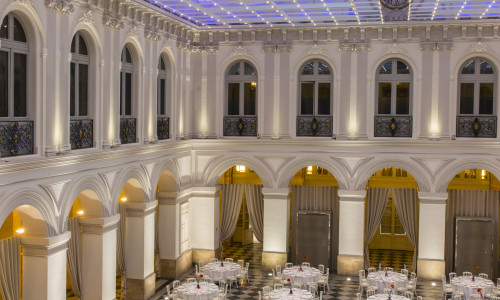
The Palais de la Bourse, also known as the Hôtel de la Bourse1, is a building in the city of Bordeaux in Gironde, France. It houses the Chamber of Commerce and Industry (CCI) of Bordeaux, the commercial court and the consular body. The building also serves as a conference space, managed by the CCI, with 150 events hosted annually.
Built between 1742 and 17494, the Palais de la Bourse is part of the architectural ensemble that is the Place de la Bourse, initially “Place Royale”. Desired by the intendant Claude Boucher, the square was to serve, thanks to a decor of ordered facades, as a setting for the equestrian statue of Louis XV, while hosting the chamber of commerce and the administration of the Farms (ancestors of customs) . The architect Jacques Gabriel will first design the facades of the Hôtel des Fermes du Roi, built between 1735 and 1738, then, after his death in 1742, it is his son Ange-Jacques Gabriel who will continue his work with the palace of the Stock Exchange, under the stewardship of the Marquis de Tourny. At the end of the project in 1749, the merchants' stock exchange (previously located on Place du Palais), the chamber of commerce and the consular jurisdiction, moved into their new premises.
Two fires, one in 1925, the other by an English bombing on December 8, 1940, destroyed part of the archives of the commercial court post-Revolution.
The chamber of commerce (CCI) and the commercial court are still in place in the building. On the other hand, the Bordeaux stock exchange, as a listing place, closed like the other regional stock exchanges in 1990, in favor of the Paris Stock Exchange.
On the first floor, the commercial court occupies the premises located on the west and south facades of the hotel; the chamber of commerce, those located on the north and east facades.
The building contains a courtyard which is now covered. It is surrounded by semi-circular arcades, garnished with clerestory iron doors. The tympanums bear various commercial emblems with the inscription of the main places in Europe. A cornice which forms a balcony marks the height of the first floor around the perimeter. Above, an entablature with triglyphs supports the birth of a vault pierced with fourteen glazed lanterns. Around this room, there are large porticos formerly containing counters, exchange offices, stores and retail shops. Two dials from 1750, made by the Bordeaux potter Hustin, one contains a clock, the other an indication of the direction of the wind, being connected to a weather vane located on the roof. This information allowed traders to assess the probability of a cargo's imminent arrival in the port, to make optimal sales or purchase decisions.
Overlooking this interior courtyard, now covered, is a monumental wrought iron door designed by the master locksmith Dumaine (1773).
In the courtroom of the commercial court there is a large canvas by Préau representing the taking of the oath of the judge-consuls. The waiting room is decorated with woodwork from the Bordeaux hotel of financier Nicolas Beaujon.
Different elements of the building (facades, roofs and staircase) are classified as historic monuments by decree of December 22, 1916 and October 26, 1942.
